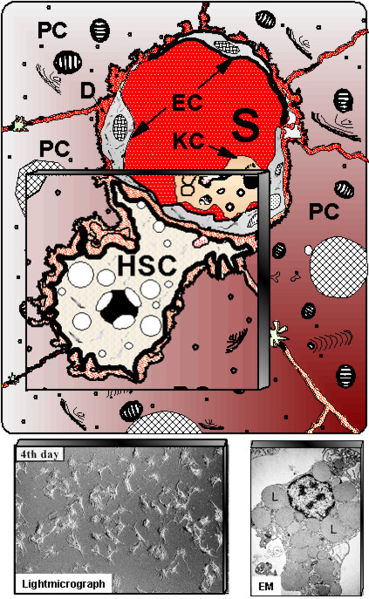Hepatic Stellate Cells
Jump to navigation
Jump to search
- AKA vitamin A-storing cells, lipocytes, interstitial cells, fat-storing cells, Ito cells
- Exist in the space between parenchymal cells and sinusoidal endothelial cells of the hepatic lobule and store 80% of retinoids in the whole body as retinyl palmitate in lipid droplets in the cytoplasm. *In physiological conditions, these cells play pivotal roles in the regulation of retinoid homeostasis; they express specific receptors for retinol-binding protein (RBP), a binding protein specific for retinol, on their cell surface, and take up the complex of retinol and RBP by receptor-mediated endocytosis. Hepatic stellate cells in arctic animals such as polar bears and arctic foxes store 20–100 times the levels of retinoids found in humans or rats. In pathological conditions such as liver fibrosis, hepatic stellate cells lose retinoids, and synthesize a large amount of extracellular matrix (ECM) components including collagen, proteoglycan, and adhesive glycoproteins. The morphology of these cells also changes from the star-shaped stellate cells to that of fibroblasts or myofibroblasts. The three-dimensional structure of ECM components was found to regulate reversibly the morphology, proliferation, and functions of the hepatic stellate cells. Molecular mechanisms in the reversible regulation of the stellate cells by ECM imply cell-surface integrin binding to ECM components, followed by signal transduction processes and then cytoskeleton assembly. Stellate cells also exist in extrahepatic organs such as pancreas, lung, kidney, and intestine. Hepatic and extrahepatic stellate cells form the stellate cell system.
- Hepatic stellate cells are derived from the neural crest and therefore express synaptophysin, GFAP, neural cell adhesion molecule, nestin, neurotrophins, and their receptors. Located between the parenchymal cell plates and endothelial linings, with long cytoplasmic filaments that connect them to endotheial cells and parenchymal cells.
- Function:
- Retinoid storage and homeostasis
- Remodelling of ECM by production of ECM components and MMPs
- Production of growth factors and cytokines (likely have a role in hepatocyte regeneration following injury)
- Contraction and dilation of the sinusoidal lumen in response to endothelin, angiotensin, thromboxane or prostaglandins.
- Exhibit 2 states:
- Quiescent
- contain cytoplasmic lipid droplets containing retinyl esters and long cytoplasmic processes with fine branches
- Activated/transdifferentiated
- lack lipid droplets, display proliferative and fibrongenic myofibroblast-like phenotype (activated state expresses alpha smooth muscle actin and desmin)
- regulated by paracrine and autocrine loops of growth factors (TGF-beta-1) eg: leading to hepatic fibrosis; replication is mainly regulated by PDGF
- Quiescent
[Cell Struct Funct (2003) 28:105-112: Hepatic stellate cells: unique characteristics in cell biology and phenotype. Sato et al.]
